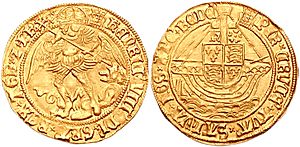Angel (coin) facts for kids
The angel was an English gold coin first made by King Edward IV in 1465. It looked a lot like the French angelot or ange coins, which had been around since 1340. The coin got its name because it showed the archangel Saint Michael fighting and defeating a dragon. Because it was a new version of an older coin called the noble, it was sometimes also called the angel-noble.
In 1472, a smaller coin called the half-angel was also made. It had a similar design and weighed about 2.6 grams, with a size of 20 to 21 millimeters.
Contents
What it Looked Like
The Front Side
The front of the coin showed Archangel Michael standing over a dragon. The dragon was meant to represent the Devil. Saint Michael was shown piercing the dragon with a spear.
The Back Side
The back of the coin usually showed a ship. Rays of the sun were often seen at the top of the ship's cross-shaped mast. There was also a small shield with the Royal Coat of Arms on the ship.
Later, starting in 1619 during King James I's reign, the design changed. It showed a galleon ship that looked a bit more three-dimensional. Its sails were decorated with the Stuart Royal Coat of Arms. Sometimes, the ship faced the right side of the coin.
The coins also had Latin phrases written on them. These phrases changed over time:
- "By Thy cross save us, Christ Redeemer." (Used from 1344 to 1553)
- "This was done by the Lord, and it is wondrous in our eyes." (Used from 1553 to 1604, adopted by Queen Mary I)
- "This was done by the Lord." (Used from 1604 to 1624, a shorter version adopted by King James I)
- "The love of the people is the protection of the king." (Used from 1625 to 1642, adopted by King Charles I)
- "To God alone the glory." (Used from 1660 to 1807, mainly on special "touch-pieces")
How Much Was It Worth?
The value of the angel coin changed quite a bit over the years. It started at 6 shillings and 8 pence when Edward IV was king. By the time of King James I, it was worth 11 shillings.
Here's how its value changed:
- In 1526, during the time of King Henry VIII, it went up to seven shillings and six pence (7/6).
- In 1544, it increased again to eight shillings (8/-).
- In 1550, during Edward VI's reign, it became worth ten shillings (10/-), which was half a pound (£0.50).
- In 1612, under King James I, it rose to eleven shillings (11/-).
- In 1619, its value dropped back to ten shillings (10/-), and the coin weighed 4.5 grams.
The last angel coins were made in 1642, just before the English Civil War (1642–1651). They were not made during the time of the Commonwealth (when England was a republic) because some people thought the coin's design was against religious beliefs.
In 1663, King Charles II introduced new coins that were made by machines. The main gold coin after that was the Guinea.
Special "Touch Pieces"
In France and England, there was a belief that the king or queen could cure a skin disease called scrofula (also known as "the king's evil") just by touching people. Kings often held special ceremonies where they would touch people suffering from this disease. Afterward, they would give each person a gold Angel coin.
After King Charles I was executed in 1649, some people believed that the Angel coins he had given out could still miraculously cure scrofula.
In 1660, King Charles II started giving out special gold-plated "touch-pieces" instead of Angel coins. Other kings and queens continued this tradition until Queen Anne died in 1714. However, Queen Mary II and William III stopped it for a short time from 1689 to 1702.
The exiled King James II and other people who claimed to be the rightful kings (called Jacobite pretenders) also continued this practice after James was removed from power in 1689. Their touch-pieces were plated with silver instead of gold to save money. The very last Jacobite touch-pieces were given out by ""Henry IX"", who was the last direct Jacobite claimant, until he died in 1807.
Social Impact
The angel coin was so well-known that many English pubs were named after it. For example, The Angel Inn in Islington, London, was one of these. The Angel tube station is named after that inn.
The angel coin was traditionally given to people with the disease known as "king's evil." This was part of a medieval ceremony where the king or queen would touch them to try and heal them. After the angel coin was no longer made, special medals with the same design, called touch pieces, were given out instead.
In 1610, a meeting of the Church of Scotland in Glasgow was nicknamed the "angelical Assembly." This was because people said that golden angel coins were given out to many ministers at the meeting.
See Also


